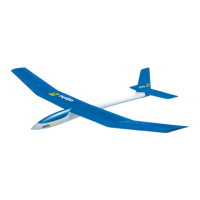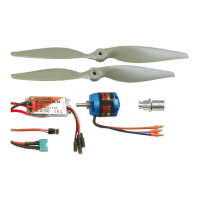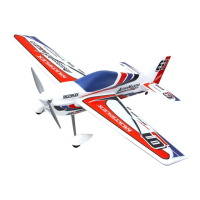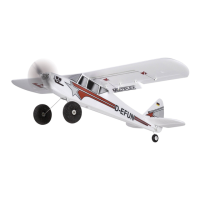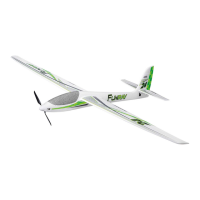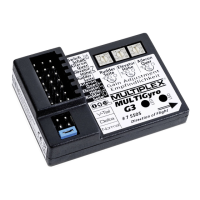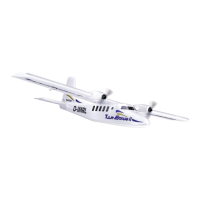low
any
bends or curves
at all. Check also that
the servo
plate
is
exactly
horizontal
in the fuselage.
Caution:
The
guide
channel
must
not
be compressed,
other-
wise the servo slide
will not be removable.
Roughen
up the inside of the
fuselage where the
guide
rail as-
sembly
fits, and spot-glue
it in
place
with s-minute
epoxy. Be
sure to check
that the servo
plate
does
not obstruct the cabin
Irame. When the
glue
has
set,
remove the wings and servo
slide
and apply a
fillet
of slow
-
setting epoxy to secure
the
plate.
Compression
strut
In an abrupt
landing, the wings will tend to swing
forward and
crush the
fuselage between the
leading
edges,
and the remov-
able compression
strut
11
avoids
this danger. Cut an 8
mm
dia-
meter hole in both
root fairings where marked. lt is best to drill
the
hole outto 7 mm diameter in stages, and
then to lile it out ca-
refully until the strut
is
a light
fit, otherwise there
is
a
good
chance that
you
will lose the strut on the trip to the
flying site. Cut
the compression
strut to
length,
and check
that it lies exactly
flush with the outside surface ofthe
rootfairings.lt
mustnot
pro-
ject
on either side.
Canopy
The fit of the canopy is one of the crucial
factors in the overall
impression
which
a
model aircraft makes, and
for
this
reason
we
strongly
recommend taking
particular
care
at this stage.
Take
your
time
-
the effort will be worthwhile.
Place
the cabin
frame on the fuselage, and check
that the fit is
exactly
righU it should be 1
mm
smaller than the cabin
flange all
round. Tape the frame on the
fuselage. Drill
the 3.5
mm diameter
hole where marked in the front of the cabin
frame,
and
the
3
mm
diameter
hole at the rear. Hold the drill at the
angle shown, and
drill through the
frame
and the
fuselage together. Insert the rivet
in
thefront
holeto check for fit, then remove the cabin
lrame and
glue
the rivet to the
frame.
Drill out the
rear hole in the tuselage to 5 mm diameter,
and
check
that the latch body 7 fits in the
hole.
Cut
a slot
(about
2
mm x'10 mm) in the fuselage for the actuating
pin;
use a 2 mm
diameter drill
at first, then open out the slot using a small
needle
file.
Hold
the latch in
position
and check that the
actuating
pin
can
be operated. Roughen up the
latch body and the inside of
the
fuselage, and apply a drop ol oil to the
pin
at either end. The
latch is fixed in the
luselage
using s-minute
epoxy.
When the
glue
has set, check
that the latch stillworks, then apply
a fillet of
slow- setting
epoxy,
preferably
thickened
as before, to secure
it
permanently.
Leave the
fuselage inverted while the resin cures.
Retract the
latch
pin
and
sand
the front face of the
latch
body
flush
with
the GRP
tuselage flange. Check that the cabin
frame
fits accurately, and
that the latch closes easily.
Trim the rear
hole in the cabin
frame if necessary.
Fit
the cabin
frame on the
fuselage and lock it in
position.
Check
thatit
issmallerthanthecanopyflange
byabout
1 mmall round.
Sand the
flange
to lhe
correct angle. Cut outthe canopy
5 along
the
marked line.The idealtoolisthe curved scissors
in the
MUL-
TIPLEX accessory
range. Trim the edge ol the canopy
until it is a
perfect
fit. lf
you
wish to
paint
the cabin
lrame, this is
your
last
chance to do so.
To avoid soiling
the fuselage, apply a coat ot
release agent
wax
or similar
material around the canopy
flange. lt can easily be
po-
lished
off again
when
the
job
is finished.
Position the canopy
frame on the
luselage
and
lock it in
place
with the
latch. Place the canopy over
the frame and
position
it
accurately.
Mark
a
line across canopy and
fuselage at front and
rear along the centre
seam using a
water
-
soluble
lelt
-
tip
pen.
Clean
the canopy and cabin
frame.
An excellent adhesive
for fixing the canopy to the
frame is clear
contact
cement. Apply a bead
of cement to the edge
of the
frame only. lt
is
essential
to work rapidly, as the
contact
glue
must
not
be
allowed to dry otf
in the normal way.
Place the canopy on
the frame, lining up the
felt-tip marks.
Fix
the canopy
in
place
with strips oI
tape, and carefully
wipe ex-
cess
glue
onto the
fuselage
side.
The contact cement
can now
be left overnight
to harden. This
is not the usual method of using
this
adhesive, but
it is ideallor our
purpose.
The
procedure
gua-
rantees a
perfect
joint
between canopy and cabin
frame.
When the
glue
has set hard
(at
least 12 hours), carefully
prise
the canopy
away
trom
the
fuselage, sliding a sharp
knife bet-
ween them
if necessary. Press the canopy
moulding onto the
't6
cabin
frame allround.
Wipe
otf
the felt- tip
marks.
Checkthe
ca-
nopy for fit, and carry out
any final trimming
required.
The canopy latch actuating
pin
can now be cut
down carefully to
a minimum
length,
so
that it is less conspicuous.
Aero
-
tow coupling
A simple and
reliable aero
-
tow coupling can
be installed asfol-
lows: file out a vertical slot about
2 x
5
mm in the
right
-
hand fu-
selage
side as
lar forward as
possible.
Drill the hole with a
1.5 mm drill
lirst, then file it out to shape.
Bend the
plastic
guide
tube 26 and steel
pushrod
37 to
match
the curvature of
the fuselage between the slot
and the servo.
Solder
a clevis to the end ol
the steel rod, slip the
rod into the
tube, and connect the clevis
to the servo output arm, as close
to
the
pivot
axis
as
possible.
When the servo output arm
is at neutral, the end ofthe steel
rod
should be
visible in the slot. Cut the steel
rod to length, and de-
burr the
cut end.
Roughen up the
guide
tube and the
luselage
side,
and epoxy the
tube in olace.
with the rod central
in
the slot.
Use scrap
wood
strips to
hold the
guide
tube against the
fuselage while the
glue
sets. Check
that the system works
reliably.
Tie
a
loop into the end of the tow cord,
and fit the
loop into the
slot. lt is retained by
the wire
pushrod.
Tailplane
Squeeze
flat one end of the
pivot
tubes
(53
front and 54
rear),
using
a
pair
of
pliers;
this
prevents
the
pivot
dowels
22 and
I
penetrating
into the foam. Cut the
pivot
tube
spacer strips
l6, r.
and 18 to length, and
arrange them
in
the
machined slots
as
shown in the drawing.
To ensure that
the tailplane
panels
are correctly
aligned
with
each other,
place
the two
panels
on a
flat
board
with the slots
up, and
weight them down
with
the
pivot
dowels litting exactly
in
the
slots. Check carefully
that the sections of the
two
panels
are
exactly
in line.
Apply strips of tape on the
tailplane skins along
the edge of the
machined slots, to
keep
glue
from the surface.
The
pivot
tubes
must
be
installed spaced correctly
to match the all-moving
crank.
The
crank
is supplied
with a
setting
-
up
jig
to
help
you
here. Fit the
pivot
dowels
(3
mm diameter
front,2 mm diameter
rear) through the appropriate
holes
in
the
jig,
and fit the
pivot
tubes onto the ends.
Now
glue
the tubes and the
corresponding
spacer strips
into the tailplane
panels.
Caution: the
pivot
tubes
must not be
glued
to the dowels.
Posi-
tion the
pivot
tubes sothatthey
project
by about3
mm
atthe
tail-
plane
root.
When the
glue
has
set
hard, sand back
the underside of
the
spacer
strips
flush with the
panel
skin.
Take care
not
to
sand
into the skin itself. Use
a
sanding
block about
300
x
60
x 19 mm,
with 8o-grit
glasspaper
glued
onto
one face. Cut
the leadi
edge
13 to length and
glue
it to the
panel,
using strips of tape
td
hold it in
place.
Plane it to the
profile
shown
in the sectional
dra-
wings, and sand to
final
shape.
Sand off the ends
of the
leading
edge, checking
that the
faces
are
flat and true.
Drill the holes
in the root ribs 15
where marked
(4
mm diameter
front, 3 mm diameter
rear), and
glue
them
to the tailplane
pa-
nels. Sand back
the root rib
flush with the tailplane skins,
and
sand the oivot
tube ends
flush.
Cut the
tips 14 to length,
glue
them to the
panels,
and sand
them
back
flush. Round ott the edges
as shown. Sand
down the trail-
ing edge to
an even thickness of
no more than
1mm.
Drill through the
pivot
holes in the
fin
using
a 4 mm diameter
drill,
drilling from both sides.
Roughen up
one end of the steel
rod 48,
slip a clevis
40 onto it, and bend
the
final 2 mm ol the
pushrod
at
right angles. Slide
the clevis back as
far as it will
go,
and solder
it
tothe
rod,taking careto
produce
asoundioint.
Connectthe
cle-
vistothe bottom hole
inthecrank, and slidethe
pushrod
intothe
upper bowden cable
outer
from
the
rear.
Position the crank so
that the
pivot
tube can be
threaiied through
it from the outside.
Cut
the
pivot
tube
to length, roughen
up the ends
and fit
it
through the
fuselage, threading the crank
onto it on the
inside.
Cutting
the curved
rear slot is a simple
job,
using a 2
mm
drill
as
a cutter,
with
the
aid of the tront
pivot
dowel and the alignment
jig.
Fit
the
pivot
dowels
22
and
23,
and
plug
in the tailplane
pa-
nels. Check that
they are accurately
aligned: the tailplane
musl
be exactly
at right-angles
to the fin. Check
that the system
works
correctly:
the rear
pivot
dowel
23
must
not rub on the

